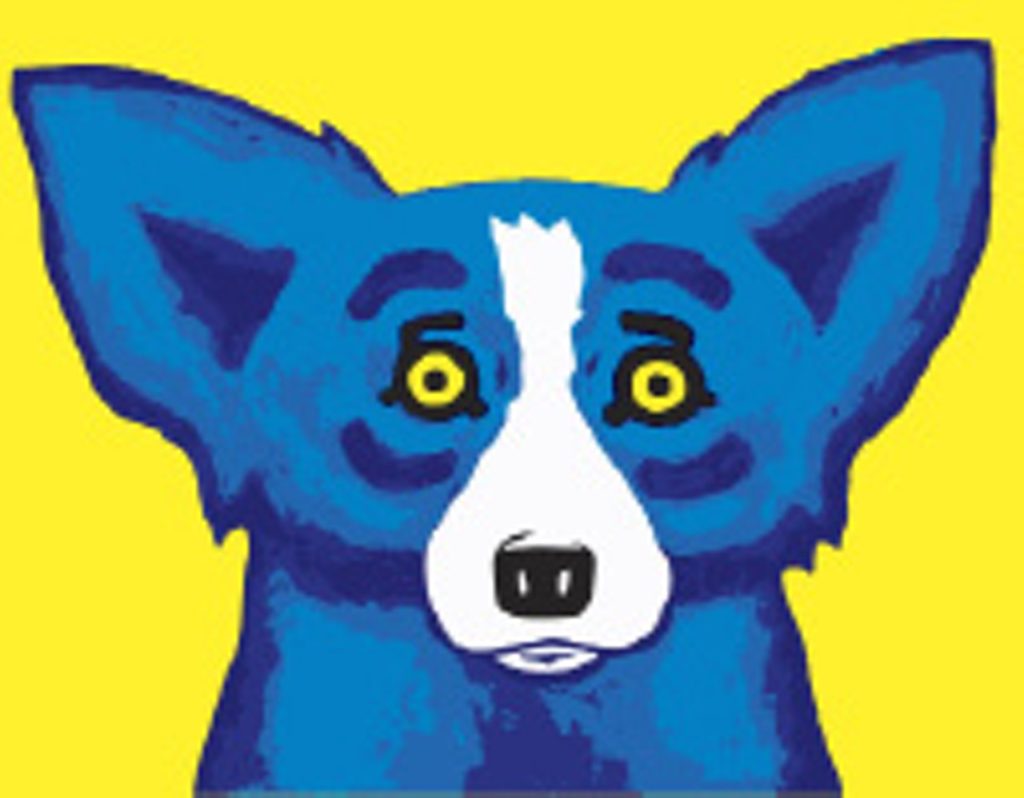Literature is full of dogs. There’s Dorothy’s sidekick Toto; Tintin’s buddy Snowy; brave Nana, who did her best to keep Wendy, Michael, and John from flying off to Neverland with Peter Pan; Tock, the watchdog, in The Phantom Tollbooth; Argos in The Odyssey – the only one to recognize his master upon his return; and Cerberus, the three-headed dog who in Greek mythology guards the entrance to the Underworld. And, of course, dozens more, fictional, non-fictional, funny, fierce, or famous.
See below for many great dog books, dog poems, resources for science (and dogs), math (and dogs), astronomy (and dogs), helpful how-tos for young dog owners, and more.
Table of Contents
DOG PICTURE BOOKS
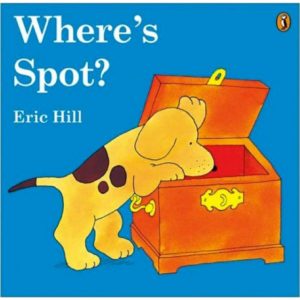 |
In Eric Hill’s Where’s Spot? (Warne, 1980), kids lift the flaps to find Spot. (Under the stairs? In the piano?) For ages 2-5. |
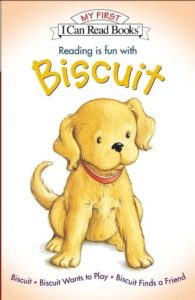 |
Alyssa Satin Capucilli’s Biscuit (HarperCollins, 2006) is a “My First I Can Read” book starring a little yellow puppy who thinks up any number of reasons not to go to bed. Many sequels. For ages 2-6. |
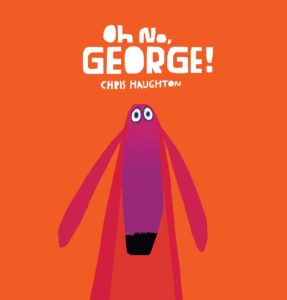 |
In Chris Haughton’s Oh No, George! (Candlewick, 2012), George intends to be good while his owner is out, but some things are just too much for him. Like cake in the kitchen and cats in the yard. For ages 2-6. |
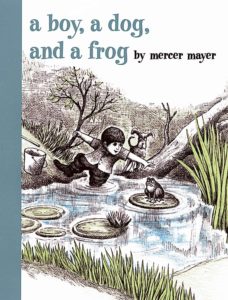 |
In Mercer Mayer’s priceless A Boy, a Dog, and a Frog (Dial, 2003), a boy and his dog discover a frog in a pond and set out to catch it. They fail, spectacularly, and eventually (frog-less) head home for a bath. The frog, left behind, misses them and by the end of the book, has followed and joined them in the tub. A simple wordless story (with more in the series) for ages 2-7. |
| See A Boy, A Dog, and a Frog on You Tube for a real-life version of the story. | |
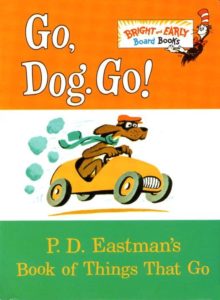 |
P.D. Eastman’s Go, Dog, Go (Random House, 1961) is a classic for beginning readers ages 3-6. |
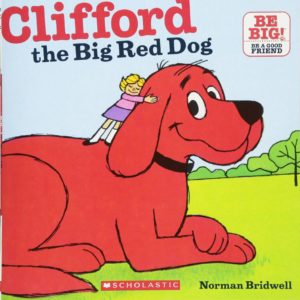 |
In Norman Bridwell’s Clifford, the Big Red Dog (Cartwheel Books, 2010), Emily Elizabeth has a truly GIANT dog. There are many books in this series for ages 3-6. |
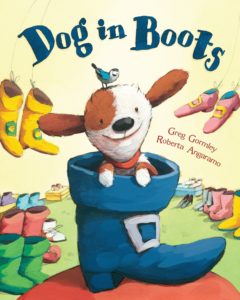 |
In Greg Gormley’s Dog in Boots (Holiday House, 2011), Dog – inspired by the story of “Puss in Boots” – heads for the shoe store for an impressive pair of boots. The boots, unfortunately, aren’t much good for digging, so back they go. Next Dog tries a pair of galoshes – which aren’t much good for swimming. Eventually he runs through a long list of footwear, from flippers to skis to high heels, only to decide that his own furry paws are the best. At the end of the book, Dog is reading a story about a girl with a terrific red hood. For ages 3-6. |
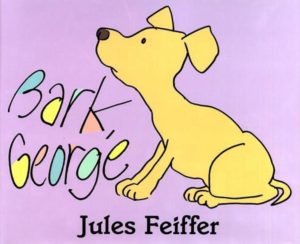
|
In Jules Feiffer’s delightful Bark, George (HarperCollins, 1999), George does everything but bark. When told by his mother to bark, George meows. “No, George,” said George’s mother. “Cats go meow. Dogs go arf. Now, bark, George.” George went: “Oink.” Funny and adorable for ages 3-7. |
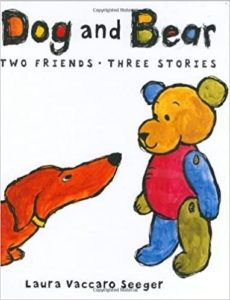
|
Laura Vaccaro Seeger’s Dog and Bear (Roaring Brook Press, 2007) is a collection of three short stories about irrepressible Dog and his shy, often baffled, best friend Bear. (They’re somewhat reminiscent of Arnold Lobel’s wonderful duo, Frog and Toad.) Dog announces that he’s changing his name. “From now on, call me SPOT.” “But you don’t have any spots,” Bear says. For ages 3-7. |
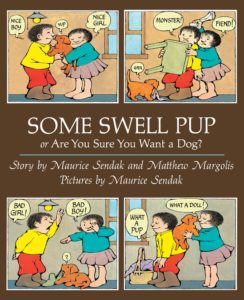 |
In Maurice Sendak’s Some Swell Pup; or, Are You Sure You Want a Dog? (Farrar, Straus & Giroux, 1976) – illustrated panel-cartoon-style – a pair of new puppy owners learn to cope with their obstreperous new charge. For ages 3-7. |
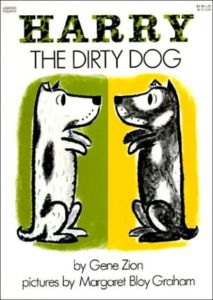 |
Gene Zion’s Harry the Dirty Dog (HarperCollins, 2006) is the story of Harry, a dog who “liked everything, except getting a bath.” That is, until one day when Harry has so many grubby adventures that he changes from a white dog with black spots to a black dog with white spots. For ages 3-8. |
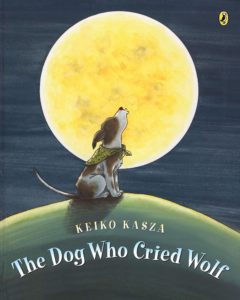
|
In Keiko Kasza’s The Dog Who Cried Wolf (Puffin, 2009), Michelle reads her dog Moka a book about wolves – and Moka immediately decides that he’d like to be a wolf, running around free, hunting wild animals, and staying up late to howl at the moon. (“Look at the way I live,” Moka sighed. “I’m nothing but a house pet.” He felt like a failure, especially when Michelle made him dress up for her tea parties.) So Moka runs away to be a wolf, which isn’t as much fun as he thought it would be. Funny and charming for ages 4-7. |
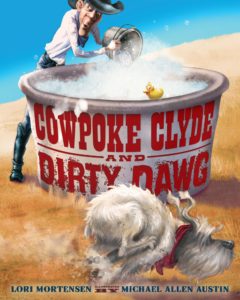
|
In Lori Mortensen’s rhyming Cowpoke Clyde and Dirty Dawg (Clarion, 2013), tidy Cowpoke Clyde has scrubbed everything in the house – except Dawg. As Clyde moves in with soap and water, Dawg bolts, and there follows a rambunctious chase involving everything from chickens to pigs, cats, and a kicking mule. For ages 4-7. |
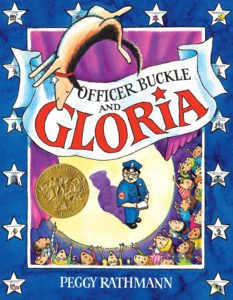
|
Peggy Rathmann’s Officer Buckle and Gloria (G.P. Putnam’s Sons, 1995), a Caldecott Medal winner, stars safety-tip-dispensing Officer Buckle and his police dog buddy, Gloria. All the kids have been bored by Officer Buckle’s lectures until Gloria chimes in with helpful demonstrations of “Never leave a thumbtack where you might sit on it!” and “Do not go swimming during electrical storms!” For ages 4-8. |
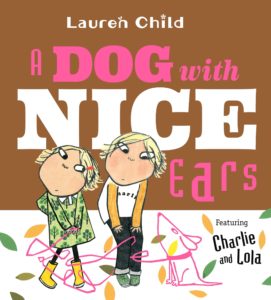
|
In Lauren Child’s A Dog with Nice Ears (Candlewick, 2018), Lola wants a dog. (Not a squirrel, not a fox, not a rabbit. A dog.) For ages 4-8. |
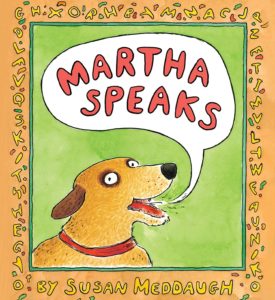
|
In Susan Meddaugh’s Martha Speaks (Houghton Mifflin Harcourt, 1992), Martha, the family dog, eats a bowl of alphabet soup – and suddenly she can talk. The problem: sometimes Martha talks too much. Many funny sequels, for ages 4-8. |
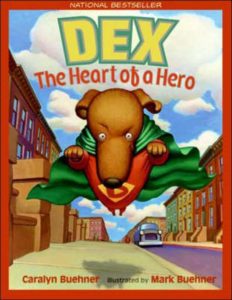 |
In Caralyn Buehner’s Dex: The Heart of a Hero (HarperCollins, 2007), Dex is a very small dog, so puny that Cleevis the cat bullies him. Dex, however, is determined to be a superhero. He heads to the library for background reading material, subscribes to an exercise regime, and even orders himself a catchy superhero suit. Soon he’s out doing good deeds – even rescuing Cleevis from a tree. By the end of the book, Dex and Cleevis have teamed up for what looks to be a beautiful and heroic friendship. For ages 4-8. |
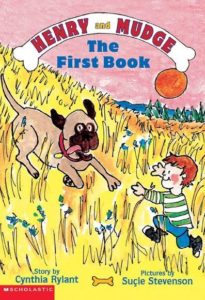
|
In Cynthia Rylant’s Henry and Mudge (Simon Spotlight, 1996), Henry, an only child who lives on a block without any other kids, is lonesome, so he asks for a dog. Enter Mudge, who rapidly goes from being a tiny puppy to a perfectly enormous dog – and Henry’s best friend. A good pick for beginning readers. Many sequels. For ages 5-7. |
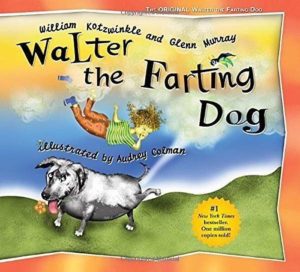
|
By William Kotzwinkle and Glenn Murray, Walter the Farting Dog (Puffin, 2008) – dedicated to “everyone who’s ever felt misjudged or misunderstood” – is the story of the unfortunate Walter, doomed to be sent to the pound for his continual farting. (This word alone sends children into giggling fits.) Then burglars break in and Walter’s affliction turns him into a hero. Several sequels. It’s not my pick, but look at all those chortling kids. For ages 5-8. Especially the ones who think “poop” is screamingly funny. |
